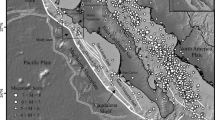Abstract
The January 17, 1994 Northridge earthquake (Mw = 6.7, 34.213° N, 118.537° W, depth = 18.4 km) was recorded extensively in the immediate source region by strong, ground motion accelerometers. The resulting seismograms show complex S wave patterns. Nevertheless, visual correlations of the strong-ground-motion velocity and displacement time-histories clearly identify two significant wave pulses: a secondary S pulse (called S2) arriving 3–5 seconds after the initial S wave pulse (called S1). A plausible assumption is that these phases are generated at areas on the rupturing thrust fault that experienced especially large slip. Conventional travel-time computations, relating the relative arrival times between the onsets of the primary S1 and secondary S2 phases, yield a hypocenter of the initiation point, constrained to a independently etimated fault plane, of the secondary wave source (called H2) at 34.26°N, 118.54° W, with a depth of 14.1 km; the 68% confidence error in depth is 1.3 km. This location is about 6 km up-dip and north from the estimated hypocenter, on the fault plane of the initial principal seismic source (called H1). The seismic moment for both the initial H1 and secondary source H2 was estimated from the SH displacement pulse. Values averaged over eight stations were 8.61 ± 9.56 × 1024 dyne-cm and 2.49 ± 2.31 × 1025 dyne-cm respectively. Reasons why the sum of the two seismic moments is smaller than the total estimated seismic moment of 1.2 × 1026 dyne-cm for the Northridge earthquake are discussed. The location of the initiation point of a second source H2 in the Northridge thrust faulting is consistent with independent computations of the fault slip pattern. The estimated stress drop for the initial and secondary sources are Δ σ1 = 150 ± 15 bars and Δ σ2 = 110 ± 11 bars, respectively.
Similar content being viewed by others
References
Aki, K. and Richards, P., 1980, Quantitative Seismology Theory and Methods, W.H. Freeman and Company, San Francisco, 913 pp.
Abrahamson, N. A. and Darragh, R. B., 1985, Observation of a double event at regional distances: the Morgan Hill earthquake of 24 April, 1984, Bull. Seis. Soc. Amer. 75, 1461–1464.
Becker, A. M., 1993, Frequency Dependent Directivity Focusing of Strong Ground Motion, Ph. D. Thesis, University of California, Berkeley, 163 pp.
Brune, J. N., 1970, Tectonics stress and the spectra of seismic shear waves from earthquakes, J. Geophys. Res. 75, 4997–5009.
Choy, G. L. and Boatwright, J., 1990, Source characteristics of the Loma Prieta, California, earthquake of 18 October, 1989 from global digital seismic data, Geophys. Res. Lett. 17, 1183–1186.
Choy, G. L. and Kind, R., 1987, Rupture complexity of a moderate sized (mb 6.0), earthquake: broadband body-wave analysis of the North Yemen earthquake of 13 December 1982, Geophys. Res. Lett. 77, 28–46.
Darragh, R., Cao, T., Cramer, C., Huang, M. and Shakal, A., 1994, Processed CSMIP strong-motion records from the Northridge, California earthquake of 17 January, 1994: Release No. 1–4, California Department of Conservation, Division of Mines and Geology, office of Strong Motion Studies, Report No. 94-06B.
Dreger, D. and Helmberger, D., 1991, Source parameters of the Sierra Madre earthquake from regional and local body waves, Geophys. Res. Lett. 18, No. 11, 2015–2018.
Dreger, D., 1994, Empirical Green's function study of the 17 January, 1994 Northridge, California Earthquake (MW=6.7), Geophys. Res. Lett. 21, No. 24, 2633–2636.
Dreger, D., Pasyanos, M., Loper, S., McKenzie, R., Gregor, N. and Romanowicz, B., 1994, The 17 January, 1994 Northridge earthquake: a regional perspective, Northridge abstracts program for the 89th annual meeting of SSA, No. 11.
Kanamori, H and Stewart, G. S., 1978, Seismological aspects of the Guatemala earthquake of 4 February, 1976, J. Geophys. Res. 83, 3427–3434.
Lahr, J., 1989, HYPOELLIPSE-a computer program for determining local earthquake hypocentral parameters, magnitude, and first motion pattern, U.S.G.S. Open File Report, 89–116.
Scientists of the U.S.G.S. and the Southern California Earthquake Center, 1994, The magnitude 6.7 Northridge, California, earthquake of 17 January 1994, Science 266, 389–397.
Thio, H. K. and Kanamori, H., 1996, Source complexity of the 1994 Northridge earthquake and its relation to aftershock mechanisms, Bull. Seis. Soc. Amer. 86, S84–S92.
Trifunac, M. D. and Brune, J.N., 1970, Complexity of energy release during the Imperial Valley, California, earthquake of 1940, Bull. Seis. Soc. Amer. 60, 137–160.
Wald, D. J. and Heaton, T. H., 1994, A dislocation model of the 1994 Northridge, California, earthquake determined from strong ground motions, U.S.G.S. Open File Report, 94–278.
Wald, D. J., Heaton, T. H. and Hudnutt, K.W., 1996, The slip history of the Northridge 1994, California, earthquake, determined from strong-motion, teleseismic, GPS, and leveling data, Bull. Seis. Soc. Amer. 86, S49–S70.
Wyss, M. and Brune, J. N., 1967, The Alaska earthquake of 28 March 1964: a complex multiple rupture, Bull. Seis. Soc. Amer. 57, 1017–1023.
Zeng, Y. and Anderson, J. 1996, A composite source model of the 1994 Northridge earthquake using genetic algorithms, Bull. Seis. Soc. Amer. 86, S71–S83.
Author information
Authors and Affiliations
Rights and permissions
About this article
Cite this article
Bolt, B.A., Gregor, N.J. Discrimination of a seismic source doublet in the Northridge, California earthquake of 17 January 1994. Journal of Seismology 1, 29–37 (1997). https://doi.org/10.1023/A:1009750118041
Issue Date:
DOI: https://doi.org/10.1023/A:1009750118041




